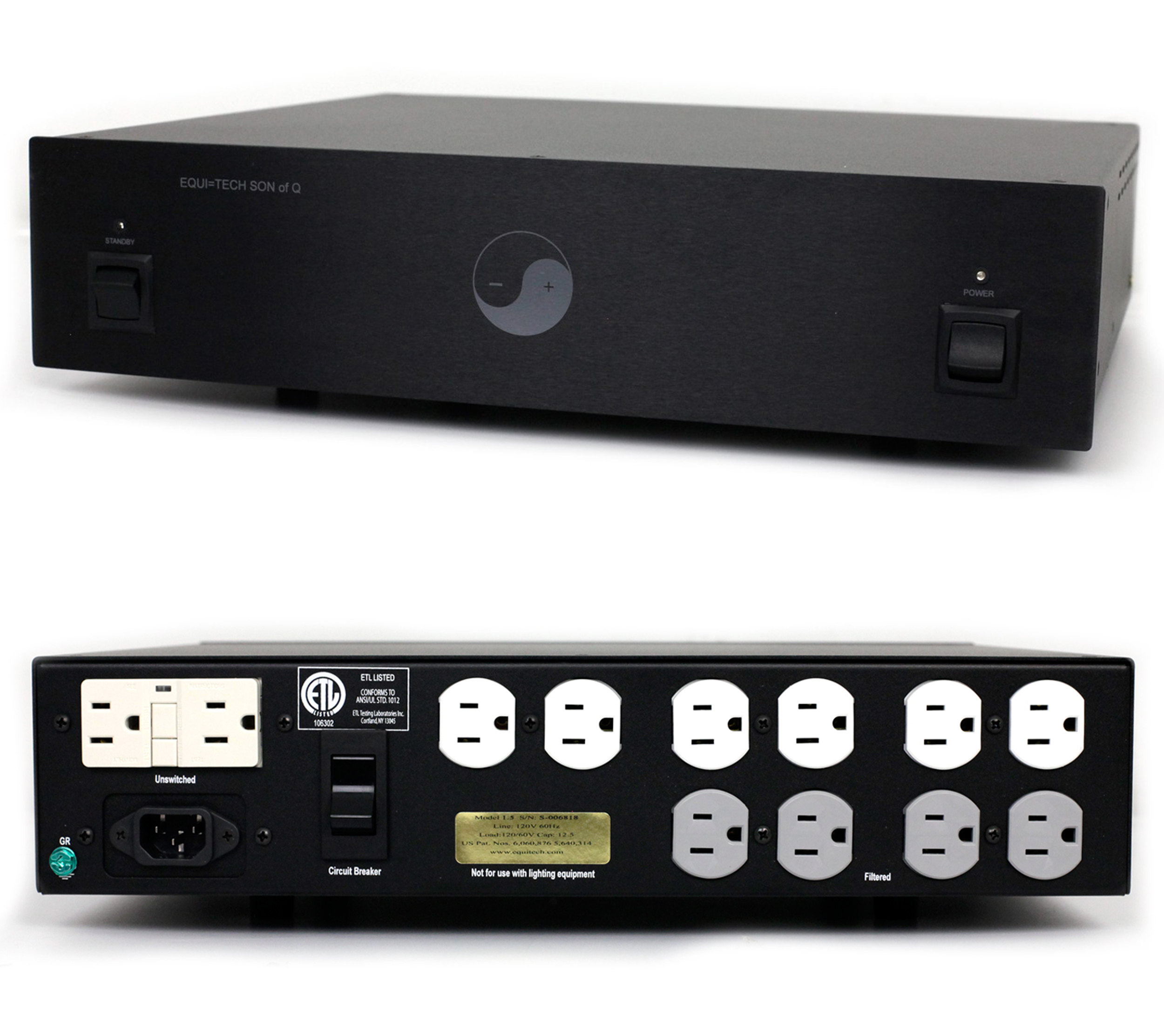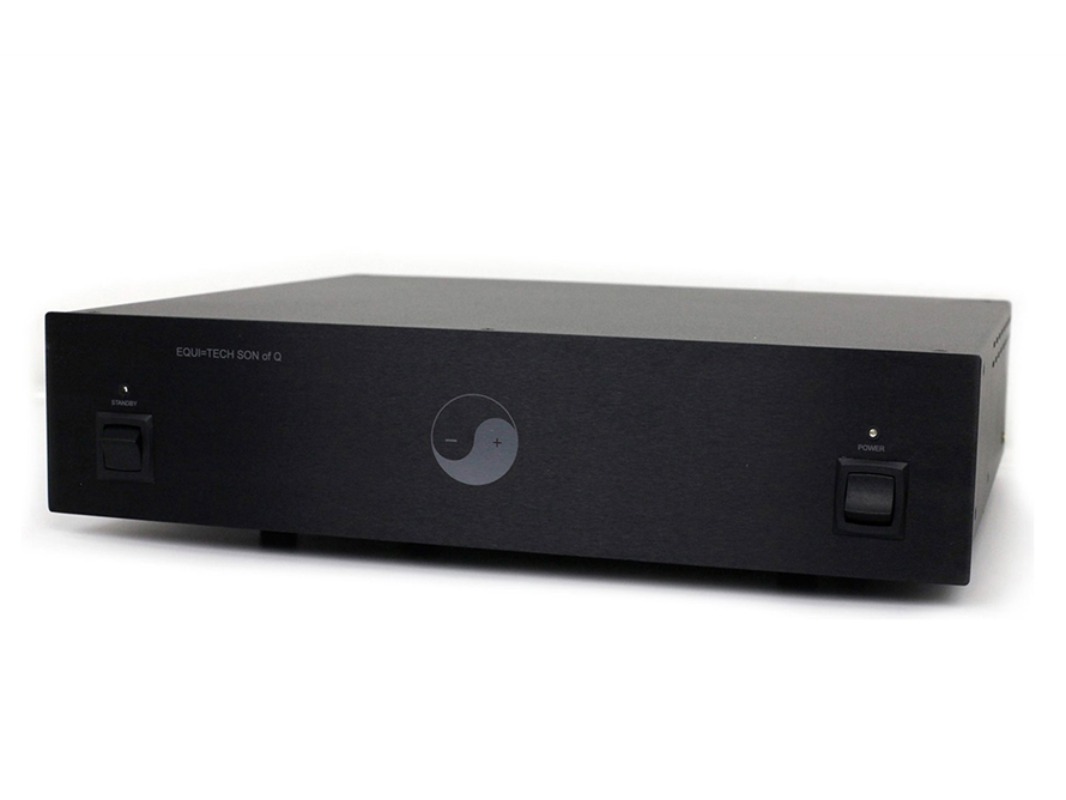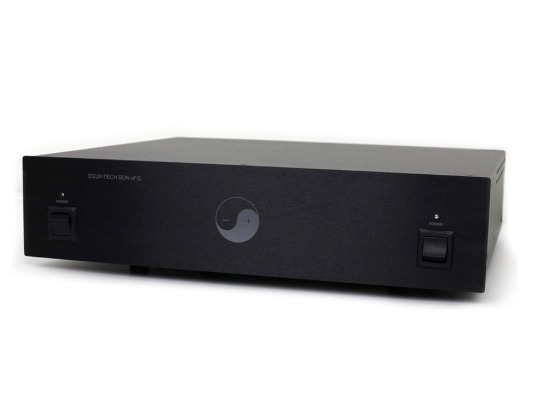 |
 |
 |
 |
 |
 |
 |
 |
 |
"선 오브 큐"는 큐의 아들 버전입니다. 큐보다는 훨씬 저렴한 가격이지만 에퀴텍의 동일한 기술력이 적용되는 모델입니다. 220볼트를 사용하는 한국에서 사용 가능한 모델은 제한적이므로 사전에 상담 후 진행해주시기 바랍니다.
“SON OF Q” SHELF OR RACK MOUNTED CHASSIS SYSTEMS

Like father, like son, sometimes the apple doesn’t fall far from the tree. Similar to the Model Q, there is something unique about the Son of Q that distinguishes it from everything else. In an audio component system, the most obvious difference is vivid low-end definition and midrange realism that broadens the sound stage and makes the listening environment seem much larger than it is. Customers tell us that they perceive a much more realistic stereo image with finer detail and subtle nuance along with perfect phasing that places instruments on a stage in a way that rivals a live performance. What it does for video is equally impressive. Blacks become blacker without sparkles. Brightly colored images retain more detail. An unmistakable and dramatic improvement in the quality of sound and video of an A/V system defines the Son of Q. The Son is offered in 3 different sizes. The original Son of Q model has a 1500 Watt capacity and plugs into any standard 15-amp 120-volt wall outlet as does it’s smaller sibling, the Son of Q Jr., which has a 1000 Watt AC load capacity. The largest of the three, the Son of Q Sr. can drive 2000 Watts of load but it requires a full sized 20-amp outlet such as the kind found near most modern kitchen countertops. They run luke water warm at the most when loaded up to full capacity. The entire Son of Q line has been thoughtfully designed with many years of balanced power manufacturing experience behind them. They are the new generation of standard systems that we build, refined beyond any product that we have ever offered in their price range.
The Son is offered in 3 different sizes. The original Son of Q model has a 1500 Watt capacity and plugs into any standard 15-amp 120-volt wall outlet as does it’s smaller sibling, the Son of Q Jr., which has a 1000 Watt AC load capacity. The largest of the three, the Son of Q Sr. can drive 2000 Watts of load but it requires a full sized 20-amp outlet such as the kind found near most modern kitchen countertops. They run luke water warm at the most when loaded up to full capacity. The entire Son of Q line has been thoughtfully designed with many years of balanced power manufacturing experience behind them. They are the new generation of standard systems that we build, refined beyond any product that we have ever offered in their price range.
Son of Qs have a simple yet elegant appearance. They feature an anodized aluminum front panel that is available in black or silver. On the front panel there are 2 LED indicator lights, one above the input power switch and one above the output standby switch that monitor power status at the input and at the output of the unit. The input power LED doubles as a TVSS status light that indicates active surge protection when lit. On rare occasion if it stops working and the output light still works, that means that the surge protector has taken a big hit and expired. In the rare event that this happens, the Son of Q transformer’s grounded Faraday shield maintains excellent backup surge protection until the TVSS can be replaced. On the back panel, there are 12 outlets provided. A GFCI outlet is independent from the front standby switch and is constantly left turned on for use with A/V components that require continuous power for a clock or to maintain memory. Of the 10 remaining outlets, 6 (white) are for analog components such as amplifiers and pre amps and 4 (gray) are specially filtered outlets for digital components. A circuit breaker on the rear panel protects the system from overload and from potential short circuit fire hazards in electrical power cords and downstream connected equipment.
Open the lid on a Son of Q and see for yourself how well made these systems truly are. There is no skimping on how Son of Qs are designed and built. All three models use isolation transformers with an enormous mass that rival competitors’ products with twice the current rating. The Son of Q Jr. is modestly rated at 1000 Watts with a transformer that compares to our competitors’ 20-amp systems. Its heart is massive and the Son of Q Sr. is literally twice the size. Son of Q transformers are designed to operate with an extremely low impedance and an extremely low magnetic flux density. This means that under load, they operate with a lot of magnetic headroom left in reserve so they can transfer current quickly upon demand to amplifier power supplies when a large transient occurs.
Many of today’s highly sophisticated electronics and A/V systems do not require a high level of continuous current to operate efficiently. They simply do not have the mass and size that requires a constant high current power source but they do often demand high current in short bursts. The Son of Qs like the Model Qs are one of the very few power products in the marketplace that can routinely maintain a high power factor when used with high current burst loads. They actually enhance amplifier performance instead of making them sound weak and compressed. It is also interesting to note that the U.S. Navy Seals use a military version of the Son of Q with their pulse radar equipment for the very same reason. Son of Qs are engineered to be an ideal match for small to medium level A/V systems and like the Model Q, their performance specifications are rated for top engineers and professionals around the world.
Son of Qs meet the highest performance standards in the power industry — standards that we ourselves created because we have been building balanced power products longer than all others. Equi=Tech literally wrote the book on balanced power. (1996 National Electrical Code Art. 530 Part “G” and 2002 NEC Art. 647 were written by Equi=Tech’s President. The new 2006 IEEE Greenbook now credits Equi=Tech and lists balanced power as a recommended method of eliminating noise in data processing systems.) The balanced power revolution started here in the early 90s and we have been setting the standards for a very long time. It’s no wonder that we do it so well. From the very beginning, Equi=Tech has been making new strides into uncharted territory. Proprietary component specifications and numerous US patents provide only a hint of the expertise we have acquired through years of experience and innovation. We are true pioneers and the Son of Q is a fine example of what we build. Equi=Tech products have earned many awards as well as a reputation in audio/video, television, theater, sporting and performance venues, R&D and scientific environments for effectiveness, reliability and as the power product of choice by top professionals around the world.
Son of Q Specifications
Model# Product
Name Output
Voltage GFCI
Protection OutputCapacity
#Circuits
Size #Outlets
Type Input
Voltage Wt.
lbs. 1.5R Son of Q
120/60
VAC Yes 1500 VA 1-15A 12-15A 120 VAC 60 lbs
27 kg
2R Son of Q Sr.
120/60
VAC Yes 2000 VA 1-20A 10-15A
2-20A
120 VAC 63 lbs
28 kg
2REA Son of Q Sr. EA
120/60
VAC Yes
2000 VA
1-20A
10-15A
2-20A 240 VAC
65 lbs
30 kg
2RE Son of Q Sr. E 230/115
VAC n/a 2000 VA 1-10A 5
Universal 230 VAC 65 lbs
30 kg
Rack mounting accessories included upon request
Chassis Dimensions: 16.25”W x 14”D x 3.5”H (2ru)
Typical AC Inlets, AC Power Cord Plugs
& Receptacle Outlets Provided With “E” (Export) Models
C13 & C14
13A 250V / 15A 125V

C19 & C20
16A 250V / 20A 125V

Universal Euro-Receptacle

Universal Schuko-Receptacle

Note: Both the Universal-Schuko and Universal-Euro receptacles can accommodate cord plugs from 20 different countries.
Standard Features
- Bifilar Wound Isolation Transformer — This patented method of winding AC power transformers is the most accurate way of all to achieve a perfectly balanced output. It is a feature that increases the performance of Equi=Tech products above all others. Perfect balance is one of the most critical of all design specifications to consider when providing a balanced power system for sensitive electronics. Because of this feature, Equi=Tech’s balanced power systems provide a wider bandwidth of noise attenuation than any other product in the marketplace. To get the best performance from one’s electronics, a perfectly mirrored output stage is crucial. This is especially true for today’s high resolution digital electronics. The result is greater definition in video and smoother and more detailed highs in music without excessive sharpness or an annoying edge. IT and other computer related systems benefit from this feature with faster throughput and fewer data errors.
- Magnetic and Faraday Shielding — These are expensive but worthwhile features built into every system we offer. The shields work to eliminate noise from the outside world as well as to protect nearby electronics from magnetic stray field radiation. Unlike similar products, Equi=Tech systems are safe to use near sensitive equipment.
- Highly Effective Redundant Surge Protection — A dual stage transient voltage surge suppressor (TVSS) is provided as a spike protection device rated at 240 joules. But count on Equi=Tech to add a thoughtful extra touch to our products. No surge suppressor made can be guaranteed to last forever. All are designed to be sacrificed for the sake of protecting your equipment in extreme circumstances that do happen. So unlike most other products in the marketplace, a useful status indicator light lets you know when your system has taken too many hits from nuisance voltage spikes and the time has come to replace the surge protection unit. Though they typically last for many years, the surge module is easy and inexpensive to replace. After all it’s better to know you have lost surge protection when it happens than to encounter a serious spike and lose your valuable components because of a worn out TVSS that you didn’t realize had already taken all it could handle. But that’s not all that we provide. As a redundant line of defense, grounded electrostatic shielding between the power transformer coils shunt dangerous voltage spikes, even huge spikes over several thousand volts for additional protection and piece of mind.
- Digital Equipment Outlets — These filtered outlets provide additional high frequency noise attenuation and isolation for switching power supplies found in typical digital electronics. These outlets are designed for use with CD Players, DVD Players, DAT Players, Dish Receivers, Hi Definition Digital Television Receivers, Plasma Displays, automation controllers, computers and other high resolution digital electronics.
- Unswitched Outlet — An entire theater, audio system or data processing system can be turned off and on from the front panel by using the front standby switch. As a convenience, one outlet on the back panel remains on all the time for equipment that uses a date/time clock such as TIVOs, VCRs, PVRs, DVRs or other components that require constant power for volatile memory.
- 100% Passive Circuitry — There are no active components used in our systems. There is nothing that will burn out or degrade from heat over time or from years of rugged use. Some systems you may encounter employ semiconductor devices to drive the outputs or soft-start relays to compensate for a low quality isolation transformer with high inrush current — not Equi=Tech! There is simply nothing in our systems to wear out or degrade over time from heavy usage or from heat. We invest money in our systems where it rightfully belongs, in well designed high quality components. So the next time you are watching a live broadcast of the Super Bowl or Presidential Inauguration, keep in mind that Equi=Tech is there running the show because top engineers know that there are times when equipment failure is not an option. Ruggedness, reliability and the most refined balanced power technology on Earth is why the top professionals in many technical fields choose Equi=Tech.
- High Efficiency — Our systems are the most efficient of their kind in the world. This means that you waste no power running an Equi=Tech to drive your electronic components. Even when they are driven hard, they generate very little heat. Most of the time, they barely run warm. They draw very little power in idle mode and can be left turned on practically forever, ready to meet the toughest power demands in an instant. In operational mode, they waste almost no electricity at all. They draw about as much power as what they are asked to put out. With a typical 97%+ efficiency rating, they easily outclass similar power products and do so in an elegant, safe and environmentally friendly way.
- Quality Tested — Equi=Tech products have been tested and certified to meet the most demanding and rigorous of all industry standards for Class A (high voltage) power distribution equipment. No one other than Equi=Tech makes a balanced power systems that meets the design criteria and safety testing procedures required by this standard. Since we initiated the balanced power revolution in the early 90’s we remain the only manufacturer of balanced power systems that is committed to meeting the high performance and safety standards required by professional engineers. Equi=Tech makes the only systems that meet stringent OSHA standards governing safety in the workplace. Not only do OSHA associates, engineers and inspectors approve our products, they have also been known to marvel at the excellence of their design and build. Electricity can be a dangerous thing if there are undetected flaws in non listed equipment or equipment inspected to meet inappropriately low standards. Unlike other manufacturers of balanced power products, we cut no corners in the design and fabrication of our systems. As we should, we take electrical safety as seriously as performance and we go the extra mile to prove it. We regard electrical safety as seriously as we regard performance and we are willing to go the extra mile to prove it. We are professionals who value our integrity and demonstrate it by the way we design and build our products. We are professionals. We are a company of conscientious people who value our integrity and demonstrate it by how we build what we sell. Our products are the real deal in every imaginable way. Unlike some manufacturers, we cut no corners in the design and fabrication of our systems.
Like father, like son, sometimes the apple doesn’t fall far from the tree. Similar to the Model Q, there is something unique about the Son of Q that distinguishes it from everything else. In an audio component system, the most obvious difference is vivid low-end definition and midrange realism that broadens the sound stage and makes the listening environment seem much larger than it is. Customers tell us that they perceive a much more realistic stereo image with finer detail and subtle nuance along with perfect phasing that places instruments on a stage in a way that rivals a live performance. What it does for video is equally impressive. Blacks become blacker without sparkles. Brightly colored images retain more detail. An unmistakable and dramatic improvement in the quality of sound and video of an A/V system defines the Son of Q. Son of Qs have a simple yet elegant appearance. They feature an anodized aluminum front panel that is available in black or silver. On the front panel there are 2 LED indicator lights, one above the input power switch and one above the output standby switch that monitor power status at the input and at the output of the unit. The input power LED doubles as a TVSS status light that indicates active surge protection when lit. On rare occasion if it stops working and the output light still works, that means that the surge protector has taken a big hit and expired. In the rare event that this happens, the Son of Q transformer’s grounded Faraday shield maintains excellent backup surge protection until the TVSS can be replaced. On the back panel, there are 12 outlets provided. A GFCI outlet is independent from the front standby switch and is constantly left turned on for use with A/V components that require continuous power for a clock or to maintain memory. Of the 10 remaining outlets, 6 (white) are for analog components such as amplifiers and pre amps and 4 (gray) are specially filtered outlets for digital components. A circuit breaker on the rear panel protects the system from overload and from potential short circuit fire hazards in electrical power cords and downstream connected equipment. Open the lid on a Son of Q and see for yourself how well made these systems truly are. There is no skimping on how Son of Qs are designed and built. All three models use isolation transformers with an enormous mass that rival competitors’ products with twice the current rating. The Son of Q Jr. is modestly rated at 1000 Watts with a transformer that compares to our competitors’ 20-amp systems. Its heart is massive and the Son of Q Sr. is literally twice the size. Son of Q transformers are designed to operate with an extremely low impedance and an extremely low magnetic flux density. This means that under load, they operate with a lot of magnetic headroom left in reserve so they can transfer current quickly upon demand to amplifier power supplies when a large transient occurs. Many of today’s highly sophisticated electronics and A/V systems do not require a high level of continuous current to operate efficiently. They simply do not have the mass and size that requires a constant high current power source but they do often demand high current in short bursts. The Son of Qs like the Model Qs are one of the very few power products in the marketplace that can routinely maintain a high power factor when used with high current burst loads. They actually enhance amplifier performance instead of making them sound weak and compressed. It is also interesting to note that the U.S. Navy Seals use a military version of the Son of Q with their pulse radar equipment for the very same reason. Son of Qs are engineered to be an ideal match for small to medium level A/V systems and like the Model Q, their performance specifications are rated for top engineers and professionals around the world. Son of Qs meet the highest performance standards in the power industry — standards that we ourselves created because we have been building balanced power products longer than all others. Equi=Tech literally wrote the book on balanced power. (1996 National Electrical Code Art. 530 Part “G” and 2002 NEC Art. 647 were written by Equi=Tech’s President. The new 2006 IEEE Greenbook now credits Equi=Tech and lists balanced power as a recommended method of eliminating noise in data processing systems.) The balanced power revolution started here in the early 90s and we have been setting the standards for a very long time. It’s no wonder that we do it so well. From the very beginning, Equi=Tech has been making new strides into uncharted territory. Proprietary component specifications and numerous US patents provide only a hint of the expertise we have acquired through years of experience and innovation. We are true pioneers and the Son of Q is a fine example of what we build. Equi=Tech products have earned many awards as well as a reputation in audio/video, television, theater, sporting and performance venues, R&D and scientific environments for effectiveness, reliability and as the power product of choice by top professionals around the world. |
Son of Q Specifications
| Product Name | Voltage | Protection | Output Capacity | Size | Type | Voltage | lbs. | |
| Son of Q | VAC | 27 kg | ||||||
| 2R | Son of Q Sr. | VAC | 2-20A | 28 kg | ||||
| 2REA | Son of Q Sr. EA | VAC | Yes | 2000 VA | 1-20A | 10-15A 2-20A | 240 VAC | 65 lbs 30 kg |
| 2RE | Son of Q Sr. E | 230/115 VAC | n/a | 2000 VA | 1-10A | 5 Universal | 230 VAC | 65 lbs 30 kg |
Chassis Dimensions: 16.25”W x 14”D x 3.5”H (2ru)
Typical AC Inlets, AC Power Cord Plugs
& Receptacle Outlets Provided With “E” (Export) Models
| C13 & C14 13A 250V / 15A 125V  | C19 & C20 16A 250V / 20A 125V  | Universal Euro-Receptacle | Universal Schuko-Receptacle
|
Note: Both the Universal-Schuko and Universal-Euro receptacles can accommodate cord plugs from 20 different countries.
|
ADDITIONAL SPECIFICATIONS
Nominal Input Voltage 120 VAC Nominal Output Voltage 120 VAC Transformer Impedance 2.8% Isolation (CMRR) 100dB TVSS 240 Joules Voltage Regulation (NLA/FLA) +/- 2.5% Max. Temp. Rise (at perimeter) 28 C. Total Relative Stay field <10-3@ .1M Noise Level <.1 Sones @ 1M EMI/RFI Filter -30dB>100kHz
| Nominal Input Voltage | 120 VAC |
| Nominal Output Voltage | 120 VAC |
| Transformer Impedance | 2.8% |
| Isolation (CMRR) | 100dB |
| TVSS | 240 Joules |
| Voltage Regulation (NLA/FLA) | +/- 2.5% |
| Max. Temp. Rise (at perimeter) | 28 C. |
| Total Relative Stay field | <10-3@ .1M |
| Noise Level | <.1 Sones @ 1M |
| EMI/RFI Filter | -30dB>100kHz |
















